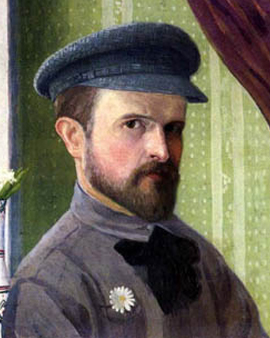



Ivan Klyun (Ivan Vasilyevich Kljun), a versatile artist, painter, graphic artist and sculptor, emerges from the vibrant art scene of the 20th century. Born in 1873 to a peasant family in Bolshye Gorky, Kljun spent most of his childhood in Ukraine before moving to Poland, then part of the Russian Empire. Here began his artistic journey, shaped by the turbulent political and cultural changes of his time.
Kljun gained his first artistic impressions in Kiev and Warsaw, where he studied art while working as an accountant. His talent led him to the Rerberg Studio in Moscow, where he met the artists Mashkov and Kazimir Severinovich Malevitsch, who significantly influenced his artistic work. Malevich in particular, the founder of Suprematism, left a profound influence on Kljun's work. Kljun's artistic path was by no means straightforward. Like many of his contemporaries, he passed through various phases and styles, from Realism to Symbolism and Art Nouveau to Impressionism and Post-Impressionism. But his work found a new direction in the 1910s, when he turned to Suprematism and Cubo-Futurism. These movements, characterized by their geometric shapes and limited color palettes, became the hallmark of his art.
However, Kljun was not only an artist, but also a dedicated educator and art curator. As director of the Central Exhibition Bureau of the IZO Narkompros, he organized numerous art exhibitions and taught at the State Free Art School/VKhUTEMAS. These experiences enabled him to actively shape and influence the avant-garde art scene of his time. Despite his enthusiasm for the avant-garde, Kljun was forced to change his artistic direction again in the 1930s. The political repressions of Stalinism and the resulting censorship of avant-garde art led Kljun to turn to socialist realism, a style that promoted idealized depictions of socialist life.
Kljun's impressive career reflects the complex and sometimes contradictory currents in 20th century art. Despite the challenges he faced, he made a significant contribution to the development of modern art. His works are exhibited in some of the world's most prestigious museums, including the Museum of Modern Art in New York and the Moderna Museet in Stockholm, and he remains an important figure in the history of the Russian avant-garde.

Ivan Klyun (Ivan Vasilyevich Kljun), a versatile artist, painter, graphic artist and sculptor, emerges from the vibrant art scene of the 20th century. Born in 1873 to a peasant family in Bolshye Gorky, Kljun spent most of his childhood in Ukraine before moving to Poland, then part of the Russian Empire. Here began his artistic journey, shaped by the turbulent political and cultural changes of his time.
Kljun gained his first artistic impressions in Kiev and Warsaw, where he studied art while working as an accountant. His talent led him to the Rerberg Studio in Moscow, where he met the artists Mashkov and Kazimir Severinovich Malevitsch, who significantly influenced his artistic work. Malevich in particular, the founder of Suprematism, left a profound influence on Kljun's work. Kljun's artistic path was by no means straightforward. Like many of his contemporaries, he passed through various phases and styles, from Realism to Symbolism and Art Nouveau to Impressionism and Post-Impressionism. But his work found a new direction in the 1910s, when he turned to Suprematism and Cubo-Futurism. These movements, characterized by their geometric shapes and limited color palettes, became the hallmark of his art.
However, Kljun was not only an artist, but also a dedicated educator and art curator. As director of the Central Exhibition Bureau of the IZO Narkompros, he organized numerous art exhibitions and taught at the State Free Art School/VKhUTEMAS. These experiences enabled him to actively shape and influence the avant-garde art scene of his time. Despite his enthusiasm for the avant-garde, Kljun was forced to change his artistic direction again in the 1930s. The political repressions of Stalinism and the resulting censorship of avant-garde art led Kljun to turn to socialist realism, a style that promoted idealized depictions of socialist life.
Kljun's impressive career reflects the complex and sometimes contradictory currents in 20th century art. Despite the challenges he faced, he made a significant contribution to the development of modern art. His works are exhibited in some of the world's most prestigious museums, including the Museum of Modern Art in New York and the Moderna Museet in Stockholm, and he remains an important figure in the history of the Russian avant-garde.
Page 1 / 1






